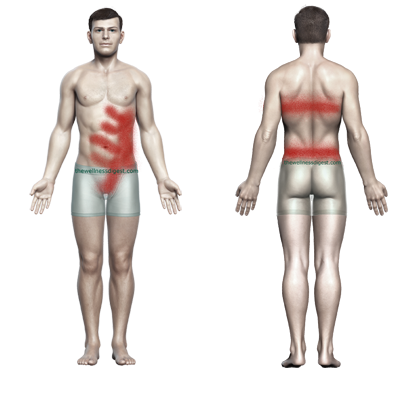The oblique are two muscles, the external oblique and the internal oblique.

External Oblique Muscle Anatomy
Origin: External surfaces of ribs 5-12
Insertion: Outer anterior half of the iliac crest, the inguinal ligament, the pubic tubercle and crest, and the aponeurosis of the anterior rectus sheath.
Actions: Flexion, Lateral flexion, rotation of the trunk, compression of the abdominal cavity
Innervation: Thoraco-abdominal nerves (T7-11) and subcostal nerve (T12)
Blood Supply: The lower two or three posterior intercostal arteries, the subcostal artery and branches from the circumflex iliac artery

Primary Actions of the External Oblique
1. Lateral flexion of the thoracic spine when acting unilaterally
Agonists: Muscles located on the same side of movement
-
-
- Iliocostalis Cervicis
- Iliocostalis Thoracis
- Iliocostalis Lumborum
- Longissimus Cervicis
- Longissimus Thoracis
- Internal Oblique
-
Antagonists: Muscles located on the opposite side of movement
-
-
- Iliocostalis Cervicis
- Iliocostalis Thoracis
- Iliocostalis Lumborum
- Longissimus Cervicis
- Longissimus Thoracis
- Internal Oblique
-
Note: Semispinalis cervicis, semispinalis thoracis, and the intertransversarii assist with lateral flexion of the thoracic spine.
2. Contralateral rotation of the trunk when acting unilaterally
Agonists: Muscles located on the same side of movement
-
-
- Semispinalis cervicis
- Semispinalis thoracis
- Multifidus
-
Antagonists: Same muscles on contralateral side
-
-
- Semispinalis cervicis
- Semispinalis thoracis
- Multifidus
-
Note: The rotatores assist with contralateral rotation of the trunk.
3. Lateral flexion of the lumbar spine when acting unilaterally
Agonists: Muscles on the same side
-
-
- Iliocostalis lumborum
- Longissimus thoracis
- Psoas major
- Quadratus lumborum
- Internal oblique
-
Antagonists: Same muscles on the contralateral side
-
-
- Iliocostalis lumborum
- Longissimus thoracis
- Psoas major
- Quadratus lumborum
- Internal oblique
-
The intertransversarii assist with lateral flexion of the lumbar spine.
Secondary Actions of the External Oblique
1. Assists with flexion of the thoracic spine when acting bilaterally
Agonists:
-
-
- Rectus abdominis
-
Antagonists:
-
-
- Iliocostalis cervicis
- Iliocostalis thoracis
- Iliocostalis lumborum
- Longissimus cervicis
- Longissimus thoracis
- Spinalis thoracis
- Semispinalis cervicis
- Semispinalis thoracis
-
Note: Internal oblique and psoas major assist with flexion of the thoracic spine.
2. Assists with flexion of the lumbar spine when acting bilaterally
Agonists:
-
-
- Rectus abdominis
-
Antagonists:
-
-
- Iliocostalis lumborum
- Longissimus thoracis
- Spinalis thoracis
-
Note: Internal oblique and psoas major assist with flexion of the lumbar spine.
3. Assists with forced expiration
Agonists:
-
-
- Serratus posterior inferior
- Transversus abdominis
-
Antagonists:
-
-
- Serratus posterior superior
- Levatores costarum breves
- Levatores costarum longi
-
Note: Rectus abdominis and external oblique assist with forced expiration.
4. Supports the abdominal wall
Agonists:
-
-
- Rectus abdominis
- Transversus abdominis
- Internal oblique
-
Antagonists: None
Internal Oblique Muscle Anatomy
Origin: Lumbar fascia, anterior two-thirds of the iliac crest, and the lateral two-thirds of the inguinal ligament
Insertion: Inferior border of ribs 10-12, aponeurosis of the rectus sheath, conjoined tendon to the pubic crest and pectineal line
Actions: Lateral flexion, flexion, and rotation of the spine
Innervation: Intercostal nerves (T7 to T12); Iliohypogastric nerve (L1); Ilioinguinal nerve (L1)
Blood Supply: The lower two or three posterior intercostal arteries, the subcostal artery and branches from the superficial epigastric artery

Primary Actions of the Internal Oblique
1. Lateral flexion of the thoracic spine when acting unilaterally
Agonists: Muscles located on the same side of movement
-
-
- Iliocostalis Cervicis
- Iliocostalis Thoracis
- Iliocostalis Lumborum
- Longissimus Cervicis
- Longissimus Thoracis
- External Oblique
-
Antagonists: Same muscles located on the opposite side of movement
-
-
- Iliocostalis Cervicis
- Iliocostalis Thoracis
- Iliocostalis Lumborum
- Longissimus Cervicis
- Longissimus Thoracis
- External Oblique
-
Note: Semispinalis cervicis, semispinalis thoracis, and the intertransversarii assist with lateral flexion of the thoracic spine.
2. Lateral flexion of the lumbar spine when acting unilaterally
Agonists: Muscles located on the same side of movement
-
-
- Iliocostalis lumborum
- Longissimus thoracis
- Psoas major
- External oblique
-
Antagonists: Same muscles on opposite side
-
-
- Iliocostalis lumborum
- Longissimus thoracis
- Psoas major
- External oblique
-
Note: The intertransversarii assist with lateral flexion of the lumbar spine.
3. Ipsilateral rotation of the trunk when acting unilaterally
Secondary Actions of the Internal Oblique
- Assists with flexion of the thoracic spine when acting bilaterally
Agonists:
-
- Rectus abdominis
Antagonists:
-
- Iliocostalis cervicis
- Iliocostalis thoracis
- Iliocostalis lumborum
- Longissimus cervicis
- Longissimus thoracis
- Spinalis thoracis
- Semispinalis cervicis
- Semispinalis thoracis
Note: External oblique and psoas major assist with flexion of the thoracic spine.
2. Assists with flexion of the thoracic spine when acting bilaterally
Agonists:
-
- Rectus abdominis
Antagonists:
-
- Iliocostalis lumborum
- Longissimus thoracis
- Spinalis thoracis
Note: External oblique and psoas major assist with flexion of the lumbar spine.
3. Assists with forced expiration
Agonists:
-
- Serratus posterior inferior
- Transversus abdominis
Antagonists:
-
- Serratus posterior superior
- Levatores costarum breves
- Levatores costarum longi
Note: Rectus abdominis and external oblique assist with forced expiration.
ADVERTISEMENT

